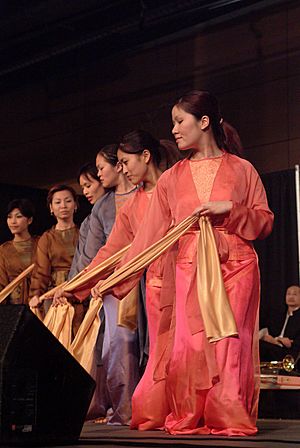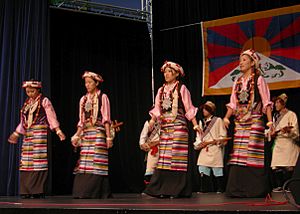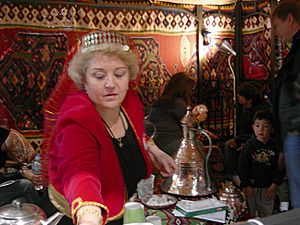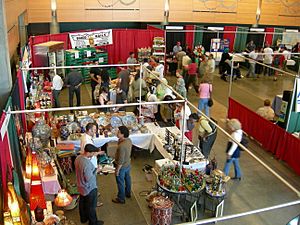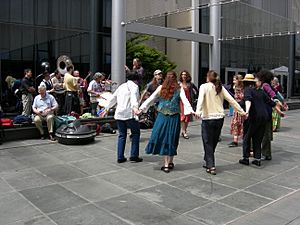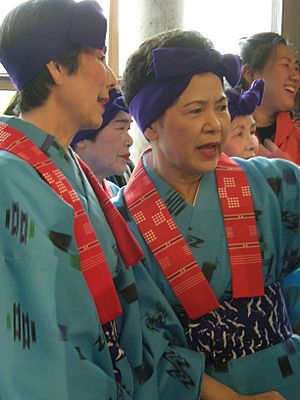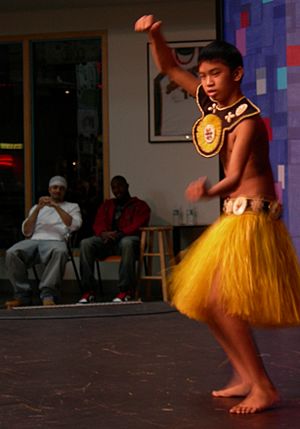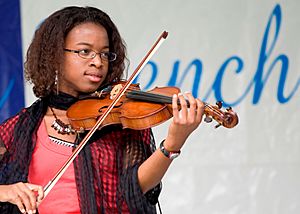Festál facts for kids
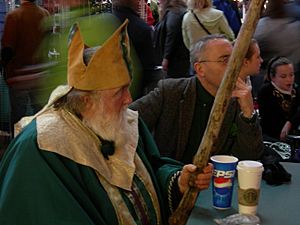
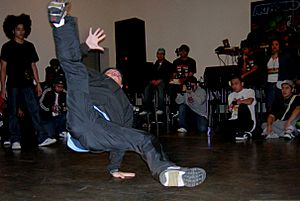
Festál is a cool series of free festivals held every year at Seattle Center in Seattle, Washington. These festivals celebrate different cultures from all over the world. They help connect Seattle to its many diverse communities. Most Festál events feature exciting performances like dances, theater, and music. You can also find marketplaces and other fun activities. These festivals are a great way for people from different backgrounds to gather and celebrate their heritage. Both kids and adults enjoy the dances and concerts.
Festál events can be different sizes. Some are smaller, while others, like the Northwest Folklife Festival, are huge! The Northwest Folklife Festival brings in about 250,000 visitors during Memorial Day weekend. Most Festál events usually attract between 5,000 and 30,000 people. Some festivals mostly draw people from the culture being celebrated. Others bring together a mix of people from all over the city. Festál started in 1996 and continues to be a big part of Seattle's cultural scene.
Contents
- Vietnam: Têt Festival
- African American: Festival Sundiata
- Ireland: The Irish Week Festival
- Japan: Seattle Cherry Blossom & Japanese Cultural Festival
- Asia-Pacific: Asian-Pacific American Heritage Month Celebration
- West Africa: Spirit of West Africa
- China: Chinese Culture and Arts Festival
- Philippines: Pagdiriwang Philippine Festival
- France: French Fest
- Iran: Iranian Festival
- Arab Middle East: Arab Festival
- Brazil: BrasilFest
- Tibet: TibetFest
- Korea: Korean Cultural and Art Festival
- Hawai`i: Live Aloha Hawaiian Cultural Festival
- Mexico and Latin America: Fiestas Patrias
- Italy: Festa Italiana
- Croatia: CroatiaFest
- South Asia: Utsav South Asian Performing Arts Festival
- Turkey: TurkFest
- Mexico: Día de Muertos
- Hmong: Hmong New Year Celebration
- Other Festivals
- See also
Vietnam: Têt Festival
The Têt Festival happens in February. It is the Vietnamese Lunar New Year celebration. This festival welcomes the start of spring. For the Vietnamese community, it's a time to think about the past year. They also get ready for the new one. People clean their homes and kitchens. New clothes are often given to mark the new year. The festival includes Vietnamese art, music, storytelling, and delicious food. There is also a fashion show.
African American: Festival Sundiata
Festival Sundiata takes place in February. It is one of the oldest festivals at Seattle Center, starting in 1981. This festival is the biggest African American celebration in Seattle. It is named after Sundiata Keita, a powerful king from the Mali Empire in West Africa. He was known for saving the Griot, who were storytellers and historians for their people. Festival Sundiata showcases many different cultural traditions. Music and dance at the festival include jazz, rap, gospel, hip-hop, R&B, and traditional African styles. Artists from the Northwest and around the world perform. The festival also has activities for kids and visual art displays.
Ireland: The Irish Week Festival
The Irish Week Festival is held around St. Patrick's Day in March. This day celebrates Ireland's patron saint. The Seattle Irish Heritage Club presents the festival. Seattle and Galway are sister cities, partly because their climates are similar. The festival includes a St. Patrick's Day parade. It goes from downtown Seattle to Seattle Center. The Irish festival weekend features traditional Irish step and jig dancing. There are also musical performances, Irish films, and sing-alongs. You can even get free lessons in Gaelic.
Japan: Seattle Cherry Blossom & Japanese Cultural Festival
In April, Seattle hosts the Cherry Blossom festival. This is the largest Japanese cultural event in the Pacific Northwest. It remembers a special gift from Japan. In 1976, Japanese Prime Minister Takeo Miki gave Seattle 1,000 cherry trees. This was part of the United States Bicentennial celebration. The trees were planted in many places around Seattle.
Every year, experts from Japan come to the festival. They teach people in Washington how to care for cherry trees. The festival aims to help people from Japan and the Northwest understand each other better. It also promotes Japanese culture, arts, and technology. This includes the achievements of the Japanese-American community. The festival features dance, music, colorful costumes, and martial arts. You can also see tea ceremonies. For children, there are Japanese games, kite making, and kimono dress-up.
Asia-Pacific: Asian-Pacific American Heritage Month Celebration
May is known as Asian Pacific Islander Heritage Month. In Seattle, the Asia-Pacific festival celebrates many cultures. These include people from China, the Philippines, Samoa, Laos, Japan, the Pacific Islands, and Cambodia. The Asian Pacific Directors Coalition organizes the festival. It features cultural arts, entertainment, and crafts. Performances include lion dances, youth drill teams, martial arts, and taiko drums.
West Africa: Spirit of West Africa
In May, the Spirit of West Africa Festival shares traditions from six West African countries. You can see exhibits, live music, dance, and storytelling. Top local and touring artists perform. They show how African roots influenced hip hop, jazz, and rock music. In workshops, you can learn about drums and dance. You can also see how drums "talk."
China: Chinese Culture and Arts Festival
Seattle has a large Chinese population. Because of this, the Chinese Culture and Arts Festival is very popular. In June, the festival offers a full look at Chinese Culture. It features Chinese performing arts and visual art displays. There are also gift booths and hands-on activities. Artists from the Pacific Northwest and China perform. You might see Chinese classical dance, folk dance, and Chinese music. There are also demonstrations of Wushu, a Chinese martial art.
Philippines: Pagdiriwang Philippine Festival
In June, Seattle celebrates Philippine culture. "Pagdiriwang" means "celebration" in Tagalog. The festival remembers when the Philippines became independent from Spain in 1898. Performing arts include pageants, music, dance, and rock bands. Other activities include food, children's games, and martial arts. This festival is known for its bright colors, beautiful fabrics, and amazing food.
France: French Fest
Seattle's French Fest celebrates French-speaking cultures. It happens every March. The festival is free and fun for families. Its goal is to share Francophone cultures and traditions from around the world. During the one-day event, you can hear live music and see theater and dance. You can also taste international foods. There are also interesting talks and demonstrations. You can play games and enjoy a day full of activities.
The festival started on March 24, 2013. It has featured many talented performers. These include dance groups, music bands, and theater groups. The festival is put on by France Education Northwest. They work with the French-American Chamber of Commerce and the French Consular Agency.
Iran: Iranian Festival
In June, the Iranian Festival is the main Iranian cultural event in the region. You can enjoy music and dance performances. There is also Rumi poetry, foods, and drinks. Displays show Persian New Year traditions and holidays. An art exhibit and puppet shows offer a peek into this rich culture. This event joined Festál in 2009. It is presented by the Iranian American Community Alliance.
Arab Middle East: Arab Festival
The Arab Festival is very important to Seattle. Seattle has one of the largest Arab American communities in the United States. The festival started in 1999. It includes all 22 Arab countries. You can find a souk (marketplace) and traditional music. There is also an authentic Arab coffeehouse. Lectures and workshops teach about the rich culture and history of Arab peoples. This is one of the world's oldest civilizations. A popular part is the Arabic rap concert. This festival happens every other year. Its dates might change based on Ramadan.
Brazil: BrasilFest
In August, BrasilFest features Brazilian drumbeats and samba rhythms. It celebrates Brazilian Folklore Day on August 22. The festival mixes traditional and modern Brazilian cultures. It is the only U.S. festival to show so much Brazilian performing arts. The music has roots in African and Portuguese traditions. The festival also shows capoeira, a unique Brazilian martial art and dance. You can see colorful costumes, taste Brazilian food, and enjoy contemporary arts.
Tibet: TibetFest
In late August, Tibet comes alive at Seattle Center. The small Tibetan community in Seattle keeps their ancient culture alive. They share their traditions through rituals and stories. You can hear centuries-old stories and melodies. You will also see masks and costumes. The festival combines old and new parts of Tibetan culture. Highlights include a Tibetan bazaar and prayer flags. There are also performers and delicious food. Artists use traditional instruments like Dra-nyen and piwang. They also use flutes, horns, drums, bells, and cymbals.
Korea: Korean Cultural and Art Festival
The Korean Festival in September is a very important event. There are strong connections between Korea and Seattle in trade, culture, and family. Every year, the festival happens on Ch'usok, or Harvest Festival Day. This is one of the biggest holidays in Korean culture. On this day, families prepare feasts. They also hold memorial services for ancestors. In the evening, people view the full moon. This Korean holiday is about being thankful for a good harvest. Like on Lunar New Year's Day, families travel from all over to celebrate together.
The festival includes folk songs, traditional and modern dance. You can also see martial arts like Tae Kwon Do. Films and exhibits show how Korean culture has changed over thousands of years. A special part is the student art competition and exhibition. Performers wear beautiful Korean traditional costumes. These costumes have rich fabrics and designs.
Hawai`i: Live Aloha Hawaiian Cultural Festival
In September, the Live Aloha Hawaiian Cultural Festival celebrates the culture of Native Hawai`i. This festival joined Festál in 2009. Over 50,000 Hawaiian Islanders now live in Washington. They share their homeland's history through live performances of the hula and mele (chants). There are also historical exhibits and films. You can find Hawaiian crafts and keiki (children's) activities. And don't forget the ono (delicious) food! The festival also has special demonstrations and lessons on traditional arts and crafts. It is presented by the Live Aloha Hawaiian Cultural Festival Committee.
Mexico and Latin America: Fiestas Patrias
Held in September, Seattle Fiestas Patrias celebrates Mexican independence. It also celebrates the independence of other Latin American countries. The festival is decorated in Mexican colors. This is to remember Mexico's independence day on September 15. Artists from countries like Peru, Honduras, Argentina, Mexico, and Colombia perform. They offer a real look at cultures that share language, food, and sounds. But they also have their own special traditions. Favorites at the festival include mariachi music, salsa dance, and traditional costumes and food.
Italy: Festa Italiana
Festa Italiana started in 1988. It is held every September. Along with the Irish and Cherry Blossom Festivals, it is one of the most popular. The festival celebrates traditional Italian culture. It also includes modern Italian performances, art, cars, and food. Every year, you can see traditional Italian folk groups. There is also Italian opera music by sopranos and pop singers. Evening wine tasting and puppet theater are also popular.
Italian chef Nick Stellino prepares Italian dishes for the audience. Annual favorites are the grape stomp and bocce ball tournament. Famous local players often come to play. The Italian-American musical group the EuroRhythms also performs.
Croatia: CroatiaFest
In early October, CroatiaFest brings in famous folk dance groups and musicians. This annual festival started in 2003. It features many performances and chances to join in the music and dance. The 2007 festival theme was "Maritime Heritage of Croatians." Many Croatian immigrants were skilled sailors from the Adriatic Sea. When they came to the Pacific Northwest, they found work in the maritime industries. Fishermen share workshops on mending nets. Other Croatians share their life stories and culture.
South Asia: Utsav South Asian Performing Arts Festival
During the second weekend of October, the Utsav festival showcases ancient traditions. It features music and dance from the South Asian subcontinent. South Asia includes Afghanistan, Bangladesh, Bhutan, India, Maldives, Nepal, Pakistan, and Sri Lanka. Artists perform art forms using instruments like the Indian lute and the sitar. There are also vocalists and yogic dance and drama. These performances use dancing bells and foot beats.
More than 1,652 different languages are spoken in India alone. South Asia has the largest Muslim population in the world. It is also where some of the world's biggest religions began. These include Hinduism, Buddhism, and Sikhism.
Turkey: TurkFest
TurkFest is held on the third weekend of October. It is a festival of friendship. It celebrates the rich cultures found across Turkey. It connects cultures from East and West. These include ancient groups like the Hittites and Assyrians. It also includes Hellenes, Romans, and Byzantines. Festival highlights include traditional folk dancing and a Turkish bazaar. You can also hear classical and modern Turkish music. A fashion show displays many traditional costumes. Shadow puppetry is presented especially for children. Turkish food is always a festival favorite.
Mexico: Día de Muertos
Día de Muertos (Day of the Dead) is a Mexican tradition. It comes from Aztec culture. This holiday celebrates life and remembers those who have passed away. The festival focuses on decorating altars. Candlelight shines on altars decorated with bright artwork and personal items. Local and visiting artists perform. They represent countries throughout Latin America. A special part is the street sandpainting. Traditionally, streets are decorated with sand paintings. These are later swept away. This symbolizes how short our lives are.
Hmong: Hmong New Year Celebration
The Hmong New Year Celebration is well-attended by both Hmong and non-Hmong people. It is the largest Hmong New Year event in the Pacific Northwest. The November event marks the end of the harvest. This is a time for Hmong people to relax and prepare special foods. It is also a time for young people to begin courtships. Most Hmong people have lived in the United States for less than 30 years. Washington's Hmong population is growing.
The festival was created to teach people about the Hmong. The Hmong people helped the U.S. in the Vietnam War. Many of their people were killed because of this. Most survivors moved to the U.S. This festival celebrates the Lunar New Year of this Southeast Asian highland culture. It comes from the mountains of China, Laos, and Thailand. Hmong people kept their stories and language alive through detailed storytelling, embroidery, music, and unique ways of communicating. Highlights include traditional ball-tossing, dances, children's activities, a fashion show, and a Hmong band. Exhibits show the history of Hmong settlement in King County. They also display traditional embroideries.
Other Festivals
- Naturalization ceremony on U.S. Independence Day
- Northwest Folklife Festival, held in May
See also
- International District, Seattle, Washington


